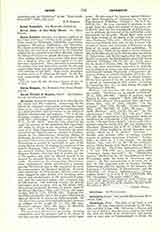

Severian, Bishop of Gabala in Syria, flourished in the fourth and fifth centuries. Concerning his life before his episcopal consecration nothing has come down to us. He was regarded by his contemporaries as a good preacher, and was known as the author of Biblical commentaries and sermons: “Vir in divinis Scripturis eruditus et in homiliis declamator admirabilis fuit” (Gennadius, “De script. eccles.” xxi, in P.L., LVIII, 1073). Posterity has preserved his name on account of the prominent but regrettable role which he played in the deposition and banishment of St. John Chrysostom. Incited by the great oratorical and financial success attained in Constantinople by his fellow-Syrian, Antiochus, Bishop of Ptolemais, Severian came to the capital about 400, provided with a series of Greek sermons. Invited by Chrysostom to preach, he succeeded, in spite of his strong Syrian accent, in winning the approval of his hearers (Sozomen, “Hist eccl.”, VIII, x). Owing to the strained relations between Chrysostom and the Empress Eudoxia, Severian had to declare for one of the parties, and, since he allowed himself to be swayed by personal interests, his choice was soon made. Nevertheless, the unsuspecting Chrysostom, when ecclesiastical affairs necessitated a journey into the Province of Asia in 401, appointed his guest his representative for liturgical functions. Severian took advantage of Chrysostom’s absence and was soon engaged in open conflict with Serapion, archdeacon and administrator of the ecclesiastical property and the episcopal palace, who remained true to Chrysostom. The resulting scandal and general excitement were so great that on his return (401) Chrysostom requested Severian to return again to his diocese (Socrates, “Hist. eccl.”, VI, xi; the longer version, ibid. in P.G., LXVII, 731). Eudoxia now interfered personally, and at her request Chrysostom allowed Severian to return to Constantinople. In this place Chrysostom delivered in Severian’s presence an address to the people (P.G., LII, 423 sqq. Severian’s answer, ibid., 425 sqq.; cf. Socrates, “Hist. eccl.”, VI, xi; Sozomen, VIII, x).
The peace thus effected was not lasting. Severian commenced anew his intrigues, and at the Synod of the Oak was one of Chrysostom’s most active opponents. He also signed the lampoon against Chrysostorn which Theophilus of Alexandria (q.v.) sent to Pope Innocent (Palladius, “Dialogus”, III, in P.G., XLVII, 14). He even ventured to proclaim to the people from the pulpit this success of his party immediately after the first banishment of Chrysostom, and to proclaim the removal of the archbishop a just punishment for his pride. Rapid flight alone saved him from violence at the hands of the enraged populace (Sozomen, VIII, xviii). Shortly after Chrysostom’s return from his first exile, we find Severian with Acacius of Bercea and Antiochus of Ptolemais at the head of the party opposed to the archbishop. It was this party which on the night of Easter Sunday, 404, incited the attack on the catechumens and clerics of Chrysostom, and finally approached the emperor directly to procure the final banishment of their hated opponent (Palladius, III, IX, loc. cit., 14, 31 sqq.). On the death of Flavian (404), the friend of Chrysostorn, this same triumvirate proceeded to Antioch, and, in defiance of justice and right, consecrated in an underhanded fashion Porphyrius (Chrysostom’s opponent) Bishop of Antioch (Palladius, XVI, loc. cit., 54). Thus ends Severian’s role in church history. Of the later period of his life and activity, as little is known as concerning the first period. According to Gennadius (loc. cit.) he died during the reign of Theodosius II (408-50).
Writings.—(I) Sermons.—Of these the following are extant: “Orationes sex in mundi creationem” (P.G., LVI, 429-500); “Oratio de serpente, quem Moyses in cruce suspendit” (ibid., 500-516); “In illud Abrahae dictum: Pone manum tuam sub femur meum, Gen., xxiv, 2” (ibid., 553-64); “De ficu arefacta” (ibid., LIX, 585-90); “Contra Judaeos” (ibid., LXI, 793-802; cf. LXV, 29 sqq.); “De sigillis librorum” (ibid., LXIII, 531-44); “In Dei apparitionem” (ibid., LXV, 26); “De pace” (ibid., LII, 425-28), completed by A. Papadopulos,`Analekta ierosolumitikes stachuologias, I (St. Petersburg, 15-26; “De nativitate Christi”, edited under Chrysostom’s name by Savile, VII, 307, but attributed by Theodoret (Eranistes, III, in P.G., LXIII, 308) to Severian; fifteen homilies in an Old Armenian translation, edited by J. B. Aucher, “Severiani… homiliee nunc primum edit ae ex antiqua versione armena in latinum sermonem translatie” (Venice, 1827), of which no. 7 is the homily “In Abrahie dictum: Gen., xxiv, 2”, no. 13 “De ficu arefacta”, and no. 10 the homily of St. Basil on Baptism (P.G., XXXI, 423-44). The Codex Ambrosianus of Milan, c. 77 sup. (VII-VIII saec.) contains eighty-eight “sermones sancti Severiani”; the “Homilarium Lacense” (Berlin Cod. lat. 341) has addresses of Peter Chrysologus under the name of “Severianus episcopus”. (2) The commentaries of Severian are all lost; he had composed such on Genesis, Exodus, Deuteronomy, Job, the Epistles to the Romans, the Galatians, I Corinthians, II Thessalonians, and the Colossians (cf. Cosmas Indicopleustes, “Topographica christ.”, I, vi, x, in P.G., LXXXVIII, 373, 417; Gennadius, “De script. eccles.” xxi).
CHRYS. BAUR

